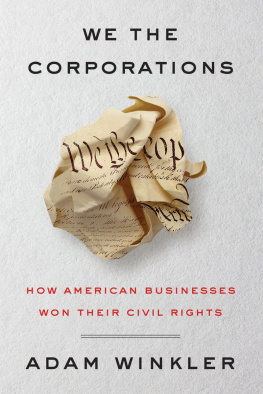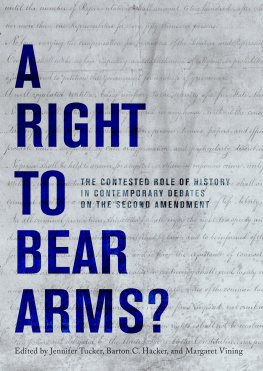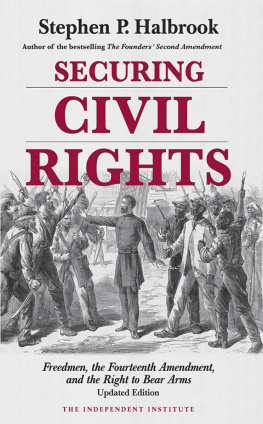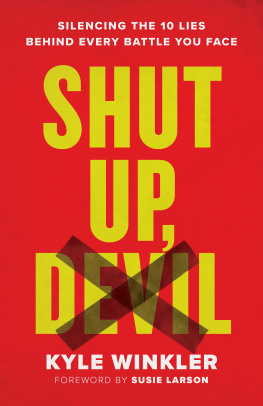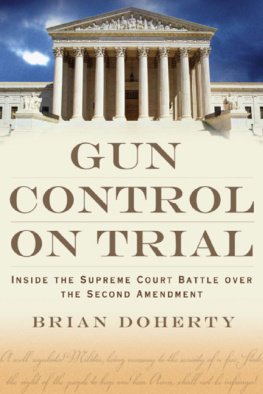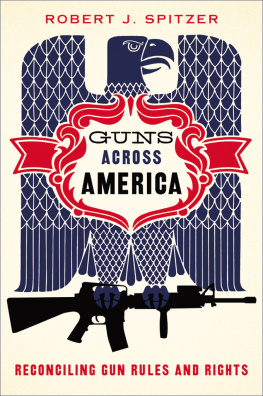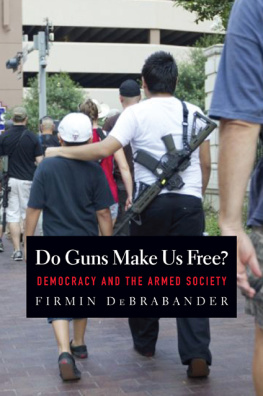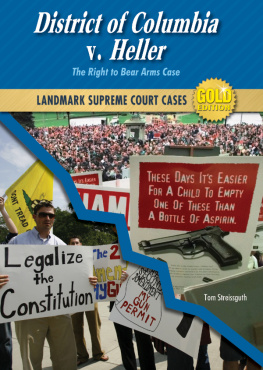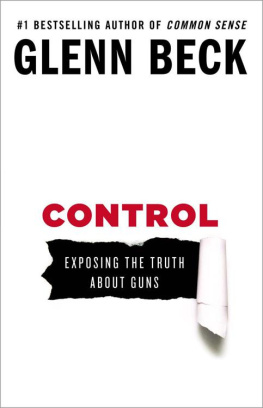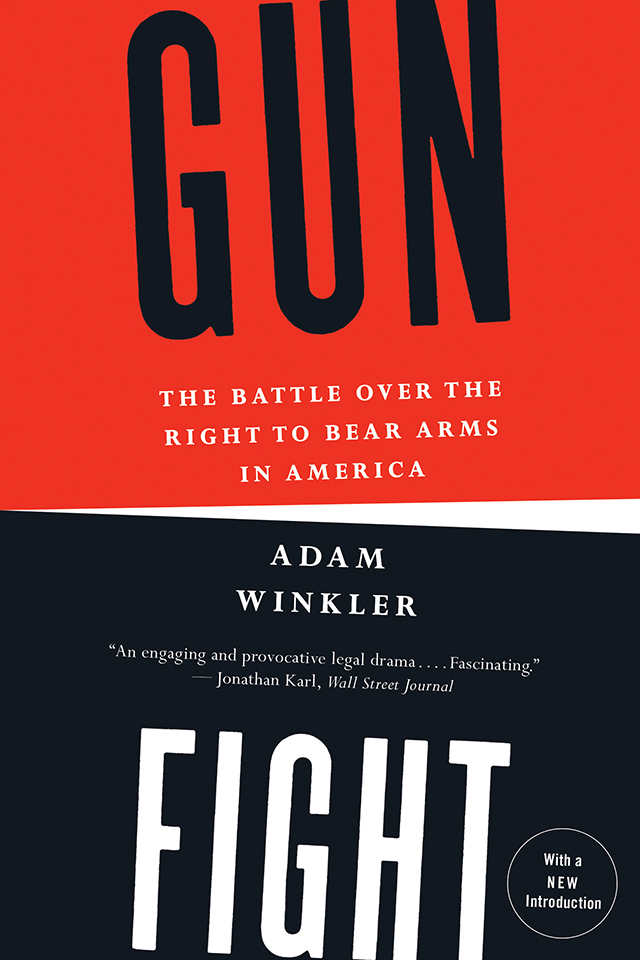
GUNFIGHT
The Battle over the Right to
Bear Arms in America
A DAM W INKLER

W. W. NORTON & COMPANY
NEW YORK LONDON
To Melissa, for her enduring inspiration;
and to Danny, for her smile.
C ONTENTS
P REFACE
W HEN PEOPLE HEARD I WAS WRITING A BOOK ABOUT GUNS, THEIR first question was always the same: Is it pro-gun or anti-gun? The goal of Gunfight , however, is to move beyond the stark, black-or-white, all-or-nothing arguments that have marked the gun debate in America over the past forty years or so. This book shows that we can have both an individual right to have guns for self-defense and, at the same time, laws designed to improve gun safety. The two ideasthe right to bear arms and gun controlare not mutually exclusive propositions. In fact, America has always had both.
The founding fathers enshrined the right to bear arms in the Second Amendment of the U.S. Constitution, but they also supported gun control laws so extensive that few Americans would today support them. They barred large portions of the population from possessing firearms, required many gun owners to register their weapons, and even conditioned the right on a persons political leanings. The Wild West, which occupies the very heart of Americas gun culture, was filled with firearms; yet frontier towns, where the civilized folks lived, had the most restrictive and vigorously enforced gun laws in the nation. Gun control is as much a part of the history of guns in America as the Second Amendment.
The longstanding effort to balance gun rights with gun control was just one of many surprising discoveries I made while researching this book. I also found that race and racism have played a central role in the evolution of gun law. Americas founders strictly prohibited slaves and even free blacks from owning guns, lest they use them for the same purpose the colonists did in 1776: to revolt against tyranny. Americas most notorious racists, the Ku Klux Klan, which was formed after the Civil War, made their first objective the confiscation of all guns from newly freed blacks, who gained access to guns in service to the Union Army. In the twentieth century, gun control laws were often enacted after blacks with guns came to be perceived as a threat to whites. Ironically, it was conservatives like Ronald Reaganstill a hero to the members of the National Rifle Associationwho promoted new restrictions on guns.
Indeed, the gun rights movement so familiar to modern-day Americans is a relatively new phenomenon, even though the ability of individuals to bear arms is one of our oldest constitutional rights. For much of its history, the NRA, which was founded in 1871 by a former reporter for a newspaper not known for its sympathy for gun rights, the New York Times , supported rather extensive gun control laws. When a wave of laws requiring a license to carry a concealed weapon swept the nation in the 1920s and 1930s, leaders of the NRA were closely involved with the drafting of the bills, which they then lobbied state governments to adopt. It wasnt until the 1970s that the NRA became the political powerhouse committed to a more extreme view of gun rights we know today.
What I learned about the Second Amendment was unexpected too. For all the attention paid to whether that ambiguously worded provision guarantees individuals a right to own guns or just protects states right to form militias, the right to bear arms has never rested primarily on the U.S. Constitution. The vast majority of statesforty-three as of this printingprotect the right of individuals to bear arms in their own state constitutions, meaning most Americans would enjoy the right regardless of the Second Amendment. And while my research led me to conclude that the NRA was correct in reading the Second Amendment to guarantee an individual right to bear arms, I was startled to discover that it was only recently that the NRA made the Second Amendment the heart of its mission. Although long a supporter of law-abiding individuals access to firearms, the NRA for most of its history ignored the Second Amendment.
It was my desire to share these discoveries, which shatter so many of the myths of Americas gun culture, that led me to write Gunfight .
PART I
CHAPTER 1
BIG GUNS AND
LITTLE GUNS AT
THE SUPREME COURT
J ASON M C C RORY AND D AN M OTT WERE THE FIRST IN line. It was early Sunday evening, and McCrory pulled his rabbit fur hat tight around his ears to protect himself from the frigid March wind whipping down First Street in Washington, D.C. A security guard told the two men, both in their early twenties, where on the sidewalk to wait. They were soon joined by two men from Phoenix, who had come straight from the airport. Then three more people arrived, with heavy winter coats, thick scarves, woolen caps, and sleeping bagseverything theyd need to sleep on the street for two nights, waiting for Tuesday morning. McCrory and Mott curled up in blankets to get some sleep, but the weather made that all but impossible. It was cold, cold, cold, McCrory recalled. After about four am, it was too cold to sleep. Despite the chill, people kept arriving and joining the queue in front of the United States Supreme Court.
The reason scores of people were willing to camp out on the street in front of the Supreme Court like groupies at a rock concert is captured in a single word: guns. The justices were scheduled to hear a case about one of the most heated, polarizing issues in America. Pro-gun and anti-gun forces debate each other with passionate intensity. One side views guns as essential to personal freedom, while the other insists they are instruments of mayhem and violence. Guns are lightning rods of American culture, and in such a charged atmosphere common ground is hard to find. Every gun control proposal is an occasion for pitched battle, with the stakes portrayed as nothing less than the future of life, liberty, and justice.
When the sun rose behind the Supreme Court Building on Tuesday morning, the culture war over guns would move into the serene and sanctified halls of the nations highest court. The justices were going to rule on a question that, incredibly, the Court had never before squarely addressed. Did the Second Amendment to the Constitution guarantee individuals the right to own guns?
The Second Amendment is maddeningly ambiguous. It provides, A well regulated Militia, being necessary to the security of a free State, the right of the people to keep and bear Arms, shall not be infringed. Yet to many of those sleeping outside the Supreme Court Building, the words couldnt be more clear. Gun rights supporters unquestionably believed that the Second Amendment guaranteed individuals the right to own guns and imposed strict limits on gun control. Gun control advocates believed that the only guarantee the Second Amendment offered was a states right to have a militia, like the National Guard, with no restrictions on gun control. For decades, the federal courts had sided with the gun control advocates, taking their cue from an ambiguous 1939 Supreme Court decision. Since then, Americas highest court had stubbornly refused to weigh in on the meaning of the Second Amendment.
The morning of the hearing, scores of protesters, reporters, and camera crews joined the street sleepers in front of the famous marble staircase of the Supreme Court. The gathering was anything but tranquil, as both sides in the gun debate were determined to be heard. They turned the steps and sidewalk in front of the ornate building into a theater of lively debate on citizens rights to own firearms, reported the Washington Post . Some carried signs declaring GUN CONTROL KILLS, MILITIAS, NOT MURDER, and the ever popular GUNS DONT KILL PEOPLE, PEOPLE DO. Well-intentioned law students in the crowd tried to mediate the chaos with thoughtful discussions about the original meaning of the Second Amendment, but the chants of a gun rights supporter with a bullhorn drowned them out. More guns! the man bellowed. Less crime! a group of fellow gun enthusiasts shouted back. More guns! Less crime!
Next page

